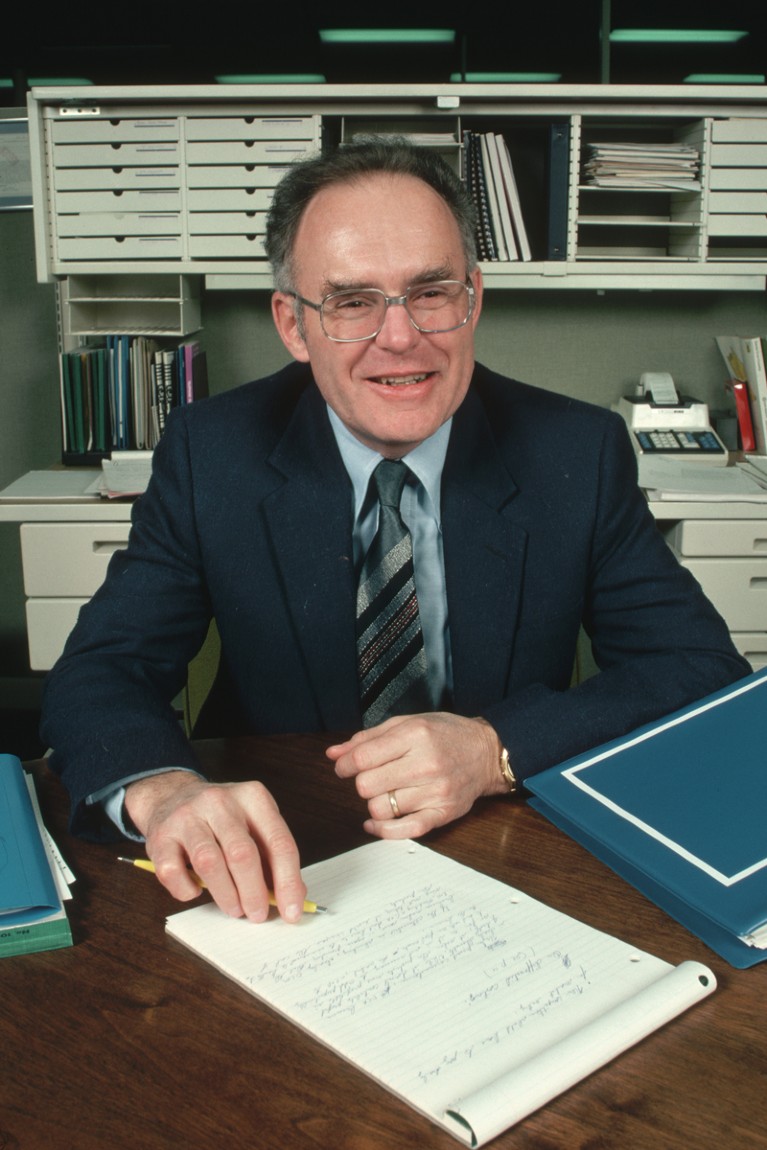
Credit: Roger Ressmeyer/Corbis/VCG via Getty
Gordon Moore played a pivotal part in the development of the semiconductor technology and industry in the United States, co-founding both Fairchild Semiconductor and Intel Corporation. He made the observation about the development of computing power now known as Moore’s Law, and established the technology road map for semiconductors that drove innovation in microelectronics, in accordance with the law, for nearly one-quarter of a century. He died on 24 March, aged 94.
Moore grew up in Pescadero, a small farming town on the California coast, south of San Francisco. At a young age, he took an avid interest in chemistry and experimented with explosives in his home laboratory. He obtained a bachelor’s degree in chemistry at the University of California, Berkeley, followed by a doctorate in physical chemistry at the California Institute of Technology (Caltech) in Pasadena. His life changed in 1956, when William Shockley, a physics Nobel laureate and co-inventor of the transistor, recruited him as a research chemist at the Shockley Semiconductor Laboratory he had recently founded in what became Silicon Valley. There, Moore learned the complex and highly experimental techniques required to produce diodes and transistors made of silicon.
In 1957, Moore and seven other scientists and engineers on the Shockley staff rebelled against their abusive and mercurial boss, establishing the Fairchild Semiconductor Corporation to specialize in high-quality silicon devices. Moore quickly became the head of the firm’s research laboratory. Under his leadership, the lab made two major innovations, the integrated circuit and the ‘planar’ transistor manufacturing process that allowed the production of reliable devices with excellent electrical characteristics. Moore gave his researchers a lot of freedom. For much of the 1960s, his lab remained the most productive in the US microelectronics industry.
Moore’s law is not just for computers
In 1965, Moore published his now-famous article, ‘Cramming more components onto integrated circuits’, in Electronics, a trade magazine. He argued that integrated circuits would rapidly grow in complexity, driving down the cost of electronic functions. ‘Moore’s plot’ showed that the number of components per microchip had doubled each year since the development of the planar transistor in 1959. He predicted that this trend would continue for ten more years. In his view, competitiveness and continued profitability in the microelectronics industry depended on it.
Moore used his plot to identify a new technical and commercial opportunity — semiconductor memory chips. This led him and Robert Noyce to leave Fairchild and found NM Electronics in 1968, the company that later became Intel. Under Moore’s direction, Intel’s engineers developed a process that used a new material, polysilicon, to form the gates of transistors that control whether they are switched on and off. This revolutionary process enabled the corporation to introduce microchips with the most transistors to the market — memory chips first and microprocessors later. Moore and his associates at Intel and Caltech also heavily promoted Moore’s plot in the semiconductor community to boost investment in the continued complexification of integrated circuits. As a result, Moore’s plot became increasingly known as Moore’s Law in the late 1970s.
Moore became Intel’s president in 1975 and chief executive in 1979, holding this position until 1987. A quiet but effective leader, he was attentive to the people around him and thought nothing of spending several hours setting up a junior staff member’s computer. Intel grew rapidly in the late 1970s, but was increasingly outpaced by Japanese firms with much lower manufacturing costs. By 1985, the company was on the brink of bankruptcy. To save it, Moore concentrated its technical capabilities on microprocessors, reforming manufacturing and stepping up the rate of technological change. He also stopped allowing other firms to produce Intel’s microprocessors, ensuring that the company had a monopoly on its own designs. This, and the rapid growth of the personal-computer market, enabled Intel to become the world’s largest chipmaker by 1992.
In AI, is bigger always better?
Moore was by then chairman of Intel’s board. To further solidify the position of Intel and other US firms in the global market and overcome obstacles to exponential complexity growth, he established the National Technology Roadmap for Semiconductors (NTRS). Gathering experts from industry, government and academia, the NTRS specified the main metrics for microchip complexity over the next 15 years for the entire US microelectronics industry, and translated them into a set of development needs for manufacturing processes. The road map set the funding priorities of the US federal government for semiconductors and oriented the research and development activities of chipmakers, equipment suppliers, academic institutions and even the National Laboratories. In 1998, the NTRS became international, guiding the development of semiconductor technology at the global scale until it folded in 2016.
In the latter part of his career, Moore focused on philanthropic pursuits. With his wife Betty, he started the Gordon and Betty Moore Foundation to improve patient care and finance research in the sciences. The foundation currently makes grants of more than US$400 million per year in health care, science and the environment. Perhaps in atonement for Intel’s poor environmental record during the 1970s, Moore also became a major patron of Conservation International, a pro-business environmental organization protecting ecosystems in more than 70 countries.

 Moore’s law is not just for computers
Moore’s law is not just for computers
 In AI, is bigger always better?
In AI, is bigger always better?
 GPT-4 is here: what scientists think
GPT-4 is here: what scientists think






